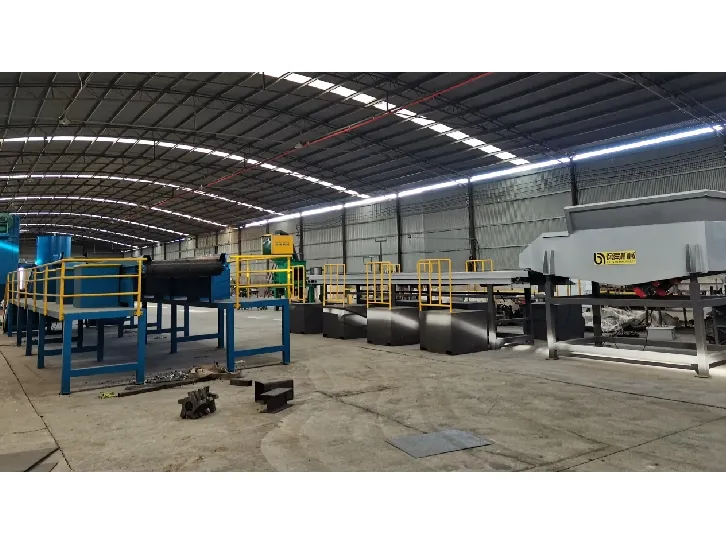

11-р сар . 14, 2024 03:36 Back to list
How Do You Dispose of Electronics? A Comprehensive Guide
In today's digital age, electronics have become an integral part of our daily lives. From smartphones and laptops to televisions and kitchen appliances, our homes are filled with gadgets that enhance our convenience. However, the rapid pace of technological advancement often leads to electronic waste, or e-waste, accumulating in households and landfills. Properly disposing of electronics is crucial to protect our environment and reduce harmful impacts on human health. In this article, we will explore the best practices for disposing of electronics responsibly.
Understanding E-Waste
E-waste refers to discarded electrical or electronic devices. This category includes out-of-date, broken, or unwanted gadgets. As technology evolves, many devices become obsolete or non-functional, contributing to a significant increase in e-waste. According to the Global E-Waste Monitor, approximately 53.6 million metric tons of e-waste were generated globally in 2019, and this number is expected to grow. Proper disposal of these items is essential to mitigate environmental risks and promote recycling efforts.
Why Proper Disposal Matters
Improper disposal of electronics can lead to a myriad of problems. Many electronic devices contain hazardous materials such as lead, mercury, and cadmium, which can contaminate soil and water supplies when dumped in landfills. Moreover, e-waste can release toxic substances into the environment if not disposed of correctly, posing serious health risks to communities. By recycling or properly disposing of electronics, we can decrease pollution, conserve natural resources, and support a circular economy where materials are reused rather than discarded.
Steps to Dispose of Electronics Responsibly
1. Assess Your Device Before disposing of any electronic device, evaluate its condition. If it is still functional, consider donating or selling it. Many charities and organizations accept used devices, which can benefit those in need while extending the lifespan of the device.

2. Data Protection If you decide to dispose of or donate a device, ensure that all personal data is deleted. Perform a factory reset, and if necessary, use data-wiping software to securely erase sensitive information. This step is crucial to protect your privacy and prevent identity theft.
3. Recycling Programs Many manufacturers and retailers offer electronic recycling programs. Check if the brand or store where you purchased the device has a take-back program. Some programs may provide incentives, such as discounts on new purchases, when you return an old device.
4. Local E-Waste Collection Events Many communities host e-waste collection events to facilitate proper recycling. These events are typically organized by local governments or environmental organizations. They provide a convenient way to dispose of electronics safely and responsibly.
5. Certified E-Waste Recyclers When selecting a recycling option, ensure that you choose a certified e-waste recycler. Look for organizations that follow environmentally responsible practices and comply with local regulations. The Responsible Recycling (R2) standard and the e-Stewards certification are two recognized benchmarks for responsible e-waste recycling.
6. Donation and Repurposing If you have older electronics that are still functional but no longer serve your needs, consider repurposing or donating them. Many schools, non-profits, and community centers welcome working devices that can be used for educational purposes.
7. Check Local Regulations Familiarize yourself with local laws concerning electronic waste disposal. Some areas have strict regulations on how e-waste should be handled, including bans on throwing electronics in the trash.
Conclusion
Disposing of electronics might seem daunting, but with the right approach, it can be straightforward and beneficial for both you and the environment. By taking proactive measures to recycle, donate, or safely dispose of e-waste, we can significantly reduce the adverse effects of electronic waste. As technology continues to evolve, let’s commit to making responsible choices that contribute to a healthier planet for future generations. Remember, the steps we take today can lead to a cleaner, greener tomorrow.
Latest news
Troubleshooting Common Eddy Separator Problems
NewsJul.04,2025
The Role of Metal Recycling Plants in Circular Economy
NewsJul.04,2025
The Impact of Recycling Line Pickers on Waste Management Costs
NewsJul.04,2025
Safety Features Every Metal Shredder Should Have
NewsJul.04,2025
How Industrial Shredders Improve Waste Management Systems
NewsJul.04,2025
How Cable Granulators Contribute to Sustainable Recycling
NewsJul.04,2025